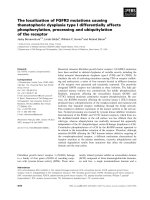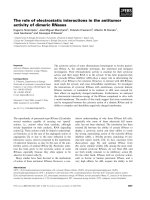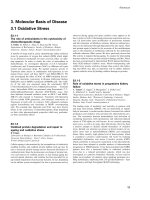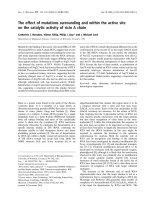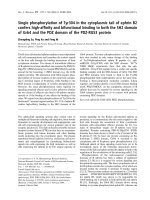Báo cáo khoa học: "THE PROCESS OF COMMUNICATION IN FACE TO FACE VS. COMPUTERIZED CONFERENCES; A CONTROL EXPERIMENT USING BALES INTERACTION PROCESS ANALYSIS" pot
Bạn đang xem bản rút gọn của tài liệu. Xem và tải ngay bản đầy đủ của tài liệu tại đây (437.75 KB, 6 trang )
THE PROCESS OF COMMUNICATION IN FACE TO FACE VS. COMPUTERIZED CONFERENCES;
A CONTROTT.~n EXPERIMENT USING BALES INTERACTION PROCESS ANALYSIS
Start Roxanne Kiltz, Kenneth Johnson, and Ann Marie Rabke
Upsala College
INTRODUCTION
A computerized conference (CC) is a form of co~znunica-
tion in which participants type into and read frc~ a
computer terminal. The participants may be on line at
the same time termed a "synchrononous" conference, or
may interact anynchronous~. The conversation is
stored and mediated by the computer.
How does this form of communication change the process
and outcome of group discussions, as compared to the
"normal" face to face (FtF) medium of group discussion,
where participants communicate by talking, listening
and observing non-verbal behavior, and where there is
no lag between the sending and receipt of communication
signals? This paper briefly ~*mmarizes the resUltS of
a controlled laboratory experiment designed to quantif~
the manner in which conversation and group decision
making varies between FtF and CC. Those who wish more
detail are referred to the literature review which
served as the basis for the design of the experiment
(Hiltz, 1975) and to the full technical report on the
results (Hiltz, Johnson, Aronovitch, and Turoff, 1980).
This paper is excerpted from a longer paper on the
analysis of communications process in the two media and
their correlates (Hiltz, Johnson and Rabke, 198Q).
0v~vIEw OF mm
z~na~T
The chief independent variable of interest is the im-
pact of computerized conferencing an a c~unications
mode upon the process and outcome of group decision
making, as compared to face-to-face discussions. Two
different types of tasks were chosen, and group size
was set at five persons.
The
subjects were Upsala
College undergraduate, graduate and continuing educa-
tion students. The communications process or profile
was quantified using Bales Interaction process Analy-
sis (see Bales, 1950).
In computerized conferenclng, each participant is
physically alone with a c~mputer terminal attached to
a telephone. In order to communicate, he or she types
entries into the terminal and reads entries sent by the
other participants, rather than speaking and listening.
Entering input and res~ttug output may be done totally
at the pace end time chosen b~ each individual. Con-
ceivably, for instance, all group members could be
entering comments simultaneously. Receipt of messages
from others is at the terminal print speed of 30 char-
acters per second.
Even when all five participants are on-line at the s~me
time, there is considerable lag in a computer confer-
ence between the time a discussant types in a co~ent,
and when a response to that comment is received.
First, each of the other participants must finish
what
they are typing at the time; then they read the
waiting item; then they may type in a response; then
the author of the original cou~ent must finish his or
her typing of a subsequent item and print and read the
response. There is thus a definite "asynchronous"
quality even to "synchronous" computer conferences.
As a result, computer conferences often develop several
simultaneous threads of discussion that are being dis-
cussed concurrently, whereas face to face discussions
tend to focus oD one single topic at a time and then
move on to subsequent topics. (See Hiltz and Turoff,
1978, for a complete description of CC as
a
mode of
cummunicatlon).
A variable of secondary Interest is problem type. Much
experimental literature indicates that the nature Of
the problem has a great deal to do with grou~ perform-
ance. One type of problem that we used is the human
relations case as developed by Bales. These are
medium complex, unsettled problems that have no speci-
fic "correct" answer. The second type was a "scienti-
fic" ~-anklng problem ( requiring no specific expertise ),
which has a single correct solution plus measurable de-
grees of bow nearly correct a groupts answer may be.
The ranking problem, "Lost in the Arctic", was adapted
for ~-~etration over a conferencing system by per-
mission of its originators (See Eady and Lafferty).
The experiments thus had a 2 x 2 factorial design (see
figure one). The factors were mode of communication
(face-to-face vs. camputerlzed conference) and problem
type (human relations vs. a more "scientific" ranking
problem with a correct answer). These factors con-
stituted the "independent variables." Each problem-
mode condition included a total of eight groups.
Figure 1
Design of the Experiment
Two by Two Factorial with Repeated Measures:
Blocks of Four
Task Task
Type A Type B
Groups
Face-to-Face 4 h
Ccmguterized
Conference ~
BACKGROUND: THE
BALES EXPERIMENTS AND
INTerACTION
PROCESS ANALYSIS
Working at the Laboratory of Social Relations at Har-
vard, Bales and his colleagues developed a set of cate-
gories and procedures for coding the interaction in
small face-to-face decision-making groups which became
very widely utilized and generated a great deal of data
about the nature of co~unicmtion and social processes
within such groups.
Coding of the co~nunications interaction by Interaction
Process Analysis involves noting who makes a statement
or non-verbal participation (such as nodding agreement);
to whom the action was addressed; and into which of
twelve categories the action best fits. These cate-
gorles are listed in subsequent tables and explained
below. The distribution of co~z~unications units among
the twelve categories constituted one of the main de-
pendent variables for this experiment. We expected
significant differences associated with mode of communi-
cation. We also expected some differences associated
with task type. We did not feel that we had enough
information to predict the directions of these differ-
ences. For almost every category, we could think of
some arguments that would lead to a prediction that the
category would be "higher" in CC, and some reasons why
it might be lower.
75
METHOD
The number of Bales units per face to face group was
much greater than the number for acc group. There-
fore, each individual and group was transformed to a
percentage distribution among the ~velve categories.
Then statistical zests were performed to determine if
there were any significant differences in IPA distri-
butions associated with mode of communication, prob-
blem, order of problem, and the interaction among
these variables in relation to the percentage distri-
bution for each of the Bales categories.
There are many different ways in which the percentages
could be computed. To take full advantage of the de-
sign, we cumputed the percentage distribution for each
individtu~l, in each condition. Thus, we actu~S-ly have
the Bales distributions for each of 80 individuals in
a face to face conference, and in a computerized con-
ference.
The mode of analysis was a two by two factorial nested
design. If there
was
no significant group effect,
then the error terms could
be "pooled", meaning
we
could
use the
80 observations as
independent
obser-
vations for statistical test purposes. We also per-
formed a non-parametric test on the dat~ for each
Bales category, which gave us similar results.
DIFFERENCES ASSOCIATED WITH COmmUNICATION MODE
Two of the detailed analysis of variance tables on
which the st~mary here is based are included as an
Appendix. Note that the analyses were first performed
separately for the two problems, using c~unication
mode as ~he independent variable. For each problem,
we tested the significance of mode of c~unication,
order (whether it was the first or second problem
solved by the group), and the interaction between mode
and order•
Listed in figures two and three is a su~nary of the
statistical results of the 24 analyses of variance
which examined observed differences between communi-
cation modes for each of the two rases. The first two
colu~us show the mean percentage of co~nunications in
each category. For example, in the first table, re-
sults for Forest Ranger, the first column shows that
on the average less than 1% of an individual's communi-
cations were verbally "showing solidarity", but in CC,
3.22% fell into this category. The third column shows
that the results for the 16 groups in the nested factor-
ial design were significant at ~he .005 level, meaning
that the probability of tae observed differences oc-
curing by chance in a sample this size is one in 200.
The fourth column shows the level of significance if
the group was not a significant variable and the obser-
vations could be pooled, with the 80 individuals
treated as independent observations. In this case,
group was significant, so the pooled analysis could not
be done.
In looking at these data, there is an apparent coding
problem. Even for the Forest Ranger problem, face to
face, we obtained a somewhat different distribution of
coding than did persons coding problem discussions such
as this who were directly trained by Bales. (See Bales
and Borgatta, 1955, p. 400 for the complete ~ qtribu-
tions). Our coding has 20% more of the statements
clsssified as "giving opinions" than Bales and Borgatta
code, and correspondingly lower percentages in all of
the other categories. This means that our results
cannot be directly compared to those of other investi-
gators, since apparently ~he training for coding inter-
preted many more statements as representing some sort
of analysis or opinion than "should" be there, accord-
ing to the distributions obtained for similar studies
by Bales and his colleagues. (Other possible explana-
tions are that Upsala College has produced an ~nusually
opinionated and analytic set of students or that the
effect of pre-experimental training in cc raises
opinion giving even in subsequent FtF discussions.)
It does not affect the comparisons among problems and
modes for this stu~, since all of the coders were
coding the data with the same guidelines and inter-
pretations. In ~he majority of cases, the same pair
of coders coded both the CC and FtF condition for the
same group. In any case, the seven individuals who
did the coding had been trained to an acceptable level
of reliability.
Figure 2
Summary of IPA Results for
Forest Ranger by
Mode of C~ unica~ion and Order
Bales
Category
Average P Si~mificance
FTF CC By Group Pooled
Shows:
Solidarity .79 3.22 .005 G3
Tension Release 3.98 .83 .0005 .0005
Agreement 13.19 4.79 .0005 .0005
Gives:
Suggestions 4.70 9.21 .i0 .i0
Opinion 54.21 53.92 X X
Orientation 12.81 16.10 .i0 .02
Asks for:
Orientation 3.27 1.58 .05 GS
Opinion 2.88 5.36 .01 .01
Su@gestions .30 .62 .25 .20
Shows:
Disagreement 4.85 2.39 .05 .05
Tension: .81 2.16 .05 .01
Problem Ist .28 1.68
Problem 2nd 1.33 2.64
Antagoni~: .75 1.67 X X
GS • Group significant cannot pool by ind/vid~
Figure 3
Suwmary of IPA Results for
Arctic by
Mode of Ct~m.unication and Order
Bales Category Avermge P Significance
FTF CC By Group Pooled
Shows:
Solidarity 1.66 2.h~ .I0 .05
Tension "~lease 7.70 1.60 .0005 .0005
Agreement 13.35 6.82 .01 GS
Gives:
Suggestions 3.56 4.89 .20 .iO
Problem ist 2.95 6.1/
Problem 2nd 4.17 3.61
Opinion 42.99 57.80 .005 G3
Orientation 14.58 11.81 .25 GS
Asks for:
Orientation 3.72 1.62
Opinion 5.15 7.~6
Suggestions l.lh .58
• 025
.20
X
•O0O5
GS
~S
76
Shows:
Disagreement 3.51 2.h6 X GS
Tension: 1.52 .64 .025 .005
Antagonism: l.ll 1.86 X GS
Problem let • 77 .73
Problem 2nd 1.45 3.00
GS = Group significant cannot pool by individual
DISCUSSION OF THE RESULTS
The twelve categories in Bales Interaction Process
Analysis can be combined into four main zhlnctional
areas. Categories 1-3 and 10-12 are the "social-emo-
tlonal" functions, oriented towards internal group pro-
cess. The first three are called "social-emotional
positive", while 10-12 are "negative". Categories 7-9
are "Task oriented", giving answers or contributions to
solving the problem faced by the group, and categories
h-6 are varieties of "asking questions" in the task
oriented area.
It will be noted, by wa~- of further introduction, that
there are some very strong differences in the profiles,
even In the same medium, depending upon the type of
task faced by the group, and that there is some inter-
action between task type and medium. For example, more
tension was shown in the arctic problem in the CC con-
dition; more in the Forest Ranger problem in the FTF
condition.
We will take each of the categories, describing more
fully what is included in them, and then discuss the
extent to which there appear to be significant differ-
ences between the media in the relative prevalence of
communications of that type. We will also try to ex-
plain the possible reasons for or implications of sig-
nificant d/fferences that are discovered.
1. "Shows solidarity, raises other's status, gives help,
reward"
Included in this category are initial and responsive
acts of active solidarity sad affection, such as saying
"hello" and making friendly or congenial remarks to
"break the ice"; praising or encouraging the other(s);
giving support or sympathy or offers of assistance;
urging harmony and cooperation. These are all overt
attempts to improve the solidarity of the group.
Note that there is a significantly greater amount of
"showing solidarity" in computerized conferencing.
This is probably because much of the behavior of this
type in a face to face situation is non-verbal, such
as smiling in a friendly manner while nodding encourage-
ment. Non verbal acts in this category are not eodable
from the tapes of the discussions. In the CC condition,
however, the participants realize that they must put
such things into words.
Another possible explanation is that the greater ten-
dency towards overt, explicit showing of solidarity is
an attempt to compensate for the perceived coldness and
impersonality of the medium.
2. "Shows Tension Release, Jokes, laughs, shows satis-
faction"
This includes expressions of pleasure or happiness,
making friendly Jokes or kidding remarks, laughing.
There was significantly more tension release overtly
expressed in the face to face groups. Much of this
was waves of laughter, particularly in the arctic prob-
lem.
The
participants did not put this into words in
the conference when typing. Observing them, however,
there was much private laughter and verbal expressions
showing "tension release", but these do not appear in
the transcript. It is part of the private "letting
down of face" that occurs but is not communicated thro-
ugh the computer.
3. "Agrees, shows passive acceptance, understands, con-
curs, complies"
This occurs as concurrence in a proposed course of
action or carrying out of any activity which has been
requested by others. There is significantly more
agreement overtly expressed in face to face confer-
ences than in computerized conferences. We suspect
that this is related to the pressure to conform
created by non-verbal behavior and the physical
presence of the other group members. In any case,
it is undoubtedly related to the greater difficulty
of CC groups in reaching total consensus.
h. "Gives SUggestion, direction, implying autonom~ for
other"
Includes giving suggestions about the task or sUgges-
ting concrete actions in the near term to attain a
group goal. There is a tendency for more suggestions
to be given by more people In computerized conferenc-
ing. This is part of
the
equalitarian tendency for
more members to actively participate in the task behav-
ior of a group in CC. In one of the problems, the
d/fference was statistically significant at the .05 le-
vel; whereas in the other, it was sizable but did not
reach statistical significance.
5. "Gives opinion, evaluation, analysis, expresses
feeling, wish"
Includes all reasoning or expressions of evaluation or
interpretation.
This is the most frequent type of co-,~unication for
both problems and Both modes. For the Bales problem,
there was no difference in its prevalence associated
with mode of co~nuaication. For the Arctic problem,
however, there ~&s a large and statisticaJ_ly significant
difference, with more opinion giving in the CC condi-
tion.
6. "Gives Orientation, information, repeats, clarifies,
confirms t,
This includes statements that are meant to secure the
attention of the other, (such as "There are two points
I'd like to make "), restating or reporting the essen-
tial content of what the group has read or said; non-
inferential, descriptive generalizations or summaries of
the sit%latlon facing the group. There are no clear dif-
ferences here. Whereas there is a statistically signif-
icant difference in the direction of giving more orien-
tation in CC for Forest Ranger, for the other problem,
the difference is reversed,
7. "Asks for orientation, information, repetition and
C On i~I rmat i on ''
There is a significant tendency for this to occur more
often in face to face discussions. This is probably
because of the frequency with which a group member does
not hear or understand the pronunciation of a sentence
or partial utterance. In CC, people are usually more
careful to state their thoughts clearly, and the recipi-
ent can read it several times rather than asking for
repetition if it is not understood the first time or is
later forgotten. We have noticedmany CC participants
going back and looking at co~nents a second or third tim~
in a face
to
face discussion, they would probably ask
something like: "What was it you said before about x?".
8. "Asks for opinion, evaluation, analysis, expression
of feeling"
?7
This occurs more frequently in ccmpuZerized confer-
encin~. For one of the problems, the difference
reached statistical significance, whereas it did
not for the other. ~his tendency to more frequent-
ly and explicitly ask for the opinions of all the
other group members, as well as to more spontane-
ously offer ones own opinions and analyses in C0,
does seem to qualitatively be characteristic of
the me~i~.
9. "Asks for s~estion, direction, possible ways
of action"
This includes all over~, explicit requests, such
as "What shall we do now?". It is not very preva-
lent in either medi,~, and there are no significant
differences.
i0. "Disagrees, shows passive rejection, formal-
ity, witholds resources"
This includes all the milder forms of disagreement
or refusal to ccaply or reciprocate. This is also
an infrequent form of communicntion, but it occurs
more in face to face discussions than in CC.
ii. "Shows tension, asks for help, withdraws out
of field"
Includes indications that the subject feels -nYious
or frustrated, with no particular other group mem-
ber as the focus of these negative feelings. The
results on this are rather puzzling. We end up
with a statistically significant tendency for there
to be more tensions when in CC for the Forest Ran-
ger problem, hut in FTF for the Arctic problem.
Substantively, the proportion of these communica-
tions is very
~m~ll in
nny c~e, and therefore,
the small differences are not importasz.
12. "Shows antagonism, deflates other's s~atus, de-
fends or asserts self"
This includes autocratic attempts to control or di-
rect others, rejection or refusal of a request, de-
riding or criticizing others.
This is infrequent in both media and there are no
significant differences.
EFFECTS OF ORDER
For the most par~, it did not matter whether the CO or
the FtF discussion was held first. However, more
saggestions were offered on the arctic problem if it
was discussed in CC as ~e first problem, but more
in FTF discussion if the FTF was preceeded by a CC
condition. This is consistent with the tendency for
CC to promote more giving of sugEestions; apparently,
the tendency carries over to a subsequent f~ce ~o face
conversation. This raises the interesting possibi'It"/
that the group process and structure can be permanently
changed by the experience of interacting through CC, a
change that will carry over even to communications in
other modes. Other pieces of evidence from other
s~udies, including self reports of participants in
long term field trials, indicate the same poasibillty.
CONCLUSION
Our investigation confirms the hypothesia that there
are some signiflcan~ differences in the group com-
munication process between face to face and compu-
ter mediated discussions. Such differences seem ~o
be associated with other characteristics of the
medium, such as the greater tendency for minorlt¥
opinions to be maintained, rather than
a
total
group consensus emerginK, in a fuller analysis (Hiltz,
Johnson, Arono~¢ch and Turoff, 1980) we show that the
observed differences in interaction profiles are highly
correlated w~h the abillty of a group to reach con-
sensus and wirer the quali~y of group decision reached.
APyzapIX
Analyses of Variance
Bales Categories by Mode and Problem
9Y~h
Hested Factorial
Arctic
Individual
% Data
Bales Category
1 - Shows Solidarity
MeLns
Mode
of
Crm unicntion
FTF CC
Order ist 1.6893 2.4348 2.0620
of
Problem 2rid 1.6228 2.4437 2.0333
1.6561
2.4392
Nested
Design
Source SS ~f MS F
A 12.2673 1 12.2673 3.9004
B .0166 1 .0166 .0053
A x B .0285 i .0285 .0091
C/AB 37.7414 12 3.1451 1.3745
S/ABC i46.~430 64 2.2881
Tot.
i~6.4967 79
Pooled ANOVA
Table Val~es Eor F
i and 12 a-e=4.75
12 and 64df-1.90
Source SS df MS F
A 12.2673 1 12.2673 5.0618 e
B .0166 1 .0166 .0068
A x B .0285 i .0285 .01,17
WG 184.18~4 76 2.4234
Tot. 196.4967 79
Table Value for F
1 and 76 df=3.97
*Significant
A =
mode
B =
order
C/AB a error term for AB, and A x B
S/ABC m error term for C/AR
WG = Pooled error term
The pooled design yields a significant difference he-
,teen the FTF and CC conditions. The CC conditions
show a greater percent .of their cn-~ents in ~he cate-
gory
of shows solidarity.
Order
of
Problem
9v~vh Nested Factorial
Forest Ranger
Individual % Data
Bales CategoI'y 3 - Agrees
Means
Mode of Co©mmu~icntion
FTF CO
lat 14.1900
5.461,5
2nd 12.1921 4.1183
9.8273
8.1552
13.1910 4.7914
78
Source
A
B
AxB
C/ABC
Sl~C
Tot.
SS
1411.0740
55.9134
2.1232
515.1580
4056.1449
60hO.4135
df
I
i
i
12
64
79
MS
1411.0740
55.9134
2.1232
42.9298
63.3772
Nested Design
F
32.8693*
1.3024
.0h95
.677~
Table Values for F
1 and 12 df=4.75
12 and 64 df=l.90
*Significant
Pooled ANOVA
The following pooled design is not really necessary
since one finds the variables significant as above.
Source SS df MS F
A Ihli.0740 1 ihli.0740 23.h598"
B 55.9134 i 55.913h .9296
A x B 2.1232 i 2.1232 .0353
WG ~571.3029 76 60.1487
Tot. 60~0.4135 79
A=mode
B=order
C/AB=error term for A, B, A x B
S/ABC=error term for C/AB
WG=Pooled error term
Table Value for F
1 and 76 df=3.97
*Significant
The nested design yields a significant difference be-
tween the FTF and CC Conditions. The FTF conditions
show a greater percent of their comments in category 3-
Agrees.
REFERENCES
Bales, Robert
1950 Interaction Process Analysis; A Method for
the Study of Small Groups. Reading, Mass; Addison
Wesley.
Bales, Robert F. and Edgar F. Borgatta
1955 "Size of Group as a Factor in the Interaction
Profile." In A.P. Hare, E. F. Borgatta and R. F.
Bales, eds., Small Groups: Studies in Social Inter-
action, pp. 396-413. New York: Knopf.
Eady, Patrick M. and J. Clayton LafferZy
1975 "The Subarctic Survival Situation." Plymouth,
Michigan: Experiential Learning Methods.
Hiltz, Starr Roxanne
1975 "Communications and Group Decision Making"; Ex-
perimental Evidence on the Potential Impact of Compu-
ter Conferencing. Newark, N.J., Computerized Confer-
enclng and Communications Center, New Jersey Institute
of Technology, Research Report No. 2.
Hiltz, Starr Roxanne, Kenneth Johnson, Charles Arono-
vitch and Murray Turoff
1980 Face to Face Vs. Computerized Conferences: A Con-
trolled Experiment.
Hiltz, Starr Roxanne, Kenneth Johnson, and Ann Marie
Rabke
1980 Communications Process and Outcome in Face to
Face Vs. Computerized Conferences.
Hiltz, Starr Roxam.ne and Murray Turoff
1978 The Network Nation: Human Commanication via Com-
puter. Reading, Mass,: Add/son Wesley Advanced Book
Program.
ACKNOWLKDG~4ENTS
The research reported here is supported by a grant from
the Division of Mathematical and Computer Sciences (MCS
78-00519). The findings and opinions reported are
solely those of the authors, and do not necessarily re-
present those of the National Science Fo~u%dation.
Murray Turoff and Charles Aronovitch played a large part
in the design and analysis for this project. We are
also grateful to Julian Scber and Peter and Trudy John-
son-Lenz for their contributions to the design of the
experiments; to John Howell and James Whitescarver for
their software design and programming support; and to
our research assistants for their dedicated efforts in
carrying out the experiments and coding questionnaires:
Joanne Garofalo, Keith Anderson, Christine Naegle, Ned
O'Donnell, Dorothy Preston, Stacy Simon and Karen Win-
ters.
We would also like to thank Robert Bales and Experimen-
tal Learning Methods for their cooperation in providing
documentation and permission to use adaptations of prob-
lem solving tasks which they originally developed.
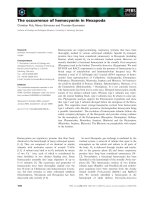
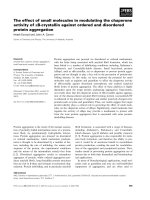
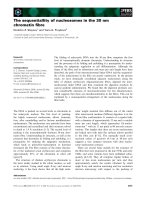
![Tài liệu Báo cáo khoa học: The stereochemistry of benzo[a]pyrene-2¢-deoxyguanosine adducts affects DNA methylation by SssI and HhaI DNA methyltransferases pptx](https://media.store123doc.com/images/document/14/br/gc/medium_Y97X8XlBli.jpg)
